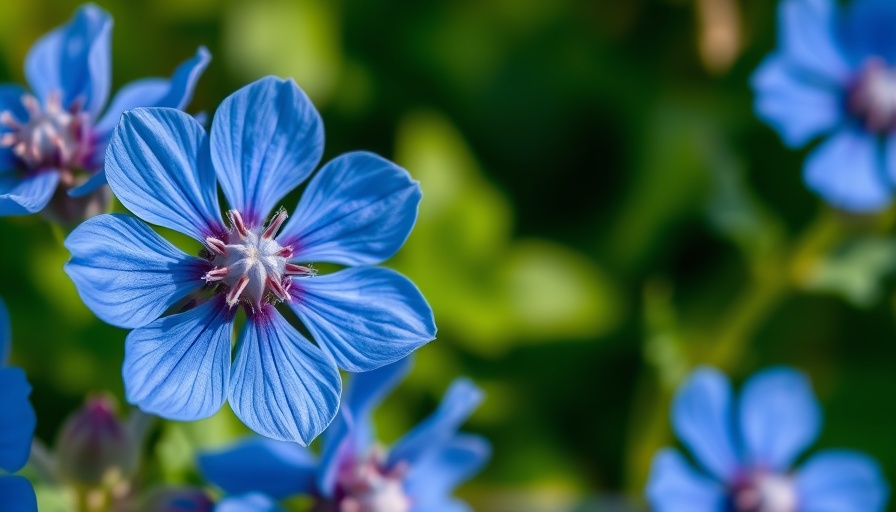
Exploring Borage: The Star-Flower of Herbal Gardens
When pondering beautiful summer flowers, few can compete with the captivating charm of borage (Borago officinalis). Its striking cobalt blue blooms are not only visually appealing but also serve various invaluable purposes in the garden. As a proud advocate for herbal gardening, it is no surprise that this medicinal herb has won its place in gardens around the globe.
The Allure and Unique Characteristics of Borage
Borage, also fondly called "starflower", is not your ordinary garden flower. Originating from southern Spain and Morocco, this annual herb boasts star-shaped flowers that transition from a vibrant blue to a soft pink as they mature. With its attractive aesthetic and its role as a pollinator magnet, particularly adored by bees, it is a must for any flower garden or herb garden.
Beyond its looks, borage offers several health benefits, making it a versatile plant choice for herb enthusiasts. This remarkable plant is prized for its cucumber-like flavor and is often used in salads, cocktails, and herbal teas. Notably, the leaves and flowers of borage are edible, providing an aromatic twist to your culinary adventures.
Historical Significance and Modern-Day Uses
Historically, borage has been revered for its medicinal properties since the time of ancient Greeks and Romans. Its calming effects on the adrenal glands make it a treasured herb for addressing stress-related conditions. Herbalists recommend borage oil to help restore vitality after periods of mental exhaustion. The historical use of borage for promoting relaxation and reducing inflammation underscores its relevance in modern wellness practices.
Additionally, traditional practitioners have formulated intriguing herbal mixtures, combining borage with other beneficial plants like mugwort and parsley to enhance spiritual awareness and promote holistic health. While these uses sound herbal and mystical, the tangible benefits of borage in the form of a tea or infusion can be both soothing and revitalizing, encouraging a deeper connection with your personal well-being.
Effects of Borage on Gardens
Incorporating borage into your landscape design has specific advantages. The vibrant blooms certainly add a pop of color, but they also play a constructive role in pest control. Borage acts as a natural bio-pesticide; its flowers attract beneficial insects, like pollinators, that can help keep harmful pests at bay. The plant also improves soil health by deepening the rooting structure, thus enhancing nutrient intake for neighboring plants.
This dual role of beauty and utility makes borage perfect for both DIY gardening projects and professional landscaping endeavors. Its hardiness and adaptability allow it to flourish in a variety of soil types, making care straightforward and rewarding.
Practical Tips for Growing Borage
For those interested in growing this stellar plant in their own yard, borage can be planted easily from seeds in spring. Given its lovely sprawling nature, it works best in raised garden beds or dedicated herb patches where its growth won’t disrupt other plants. It's crucial to remember that while borage thrives in well-drained soil, it prefers slightly moister conditions, especially in the heat of summer.
Regular pruning encourages bushier growth and prolongs blooming, while leaving some blooms to go to seed can help maintain future generations of this enchanting herb in your garden. When it comes to harvesting, both the flowers and leaves are best utilized fresh to capture their maximum flavor and nutrient profile.
FAQ About Borage: Your Essential Guide
1. Can borage survive the winter?
While typically an annual, borage can self-seed, allowing it to return in subsequent growing seasons if conditions are favorable.
2. Is borage safe for consumption?
The flowers and leaves are edible and safe for most people. However, those with specific allergies should consult a healthcare professional.
3. How does borage help with pests?
Borage attracts beneficial insects like bees and ladybugs, which prey on common garden pests, promoting a healthy ecosystem.
The Gift of Borage to Your Garden
In essence, borage is more than just a pretty face in the garden. It embodies a deep-rooted history, provides culinary and medicinal benefits, and contributes positively to the ecosystem. Whether you're a seasoned gardener or starting your green journey, embracing borage will enhance both your garden’s aesthetic and health.
If this guide has inspired you to incorporate borage into your own botanical paradise, why not delve deeper into the secrets of herbal gardening? Explore more about companion planting, organic gardening, and the intriguing world of plants that not only beautify but also enrich our lives!
 Add Row
Add Row  Add
Add 




Write A Comment